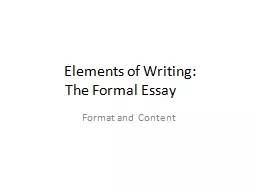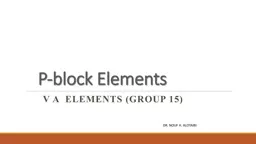PPT-Elements of Writing:
Author : natalia-silvester | Published Date : 2016-03-24
The Formal Essay Format and Content Introductory Paragraph take note The introductory paragraph sets up the material to be used in the development of a complete
Presentation Embed Code
Download Presentation
Download Presentation The PPT/PDF document "Elements of Writing:" is the property of its rightful owner. Permission is granted to download and print the materials on this website for personal, non-commercial use only, and to display it on your personal computer provided you do not modify the materials and that you retain all copyright notices contained in the materials. By downloading content from our website, you accept the terms of this agreement.
Elements of Writing:: Transcript
Download Rules Of Document
"Elements of Writing:"The content belongs to its owner. You may download and print it for personal use, without modification, and keep all copyright notices. By downloading, you agree to these terms.
Related Documents


![[EBOOK] - 5 Kinds of Nonfiction: Enriching Reading and Writing Instruction with Children\'s](https://thumbs.docslides.com/901384/ebook-5-kinds-of-nonfiction-enriching-reading-and-writing-instruction-with-children-s-books.jpg)
![[READ] - 180 Days of Writing for Fifth Grade - An Easy-to-Use Fifth Grade Writing Workbook](https://thumbs.docslides.com/901394/read-180-days-of-writing-for-fifth-grade-an-easy-to-use-fifth-grade-writing-workbook-to-practice-and-improve-writing-skills.jpg)
![[DOWNLOAD] - The Teacher\'s Big Book of Graphic Organizers: 100 Reproducible Organizers](https://thumbs.docslides.com/901411/download-the-teacher-s-big-book-of-graphic-organizers-100-reproducible-organizers-that-help-kids-with-reading-writing-and-the-co.jpg)
![[EPUB] - 180 Days of Writing for Second Grade - An Easy-to-Use Second Grade Writing Workbook](https://thumbs.docslides.com/901424/epub-180-days-of-writing-for-second-grade-an-easy-to-use-second-grade-writing-workbook-to-practice-and-improve-writing-skills.jpg)
![[DOWNLOAD] - 180 Days of Writing for Third Grade - An Easy-to-Use Third Grade Writing](https://thumbs.docslides.com/901429/download-180-days-of-writing-for-third-grade-an-easy-to-use-third-grade-writing-workbook-to-practice-and-improve-writing-skills.jpg)
![[EBOOK] - Teaching Writing in Kindergarten: A Structured Approach to Daily Writing That](https://thumbs.docslides.com/901683/ebook-teaching-writing-in-kindergarten-a-structured-approach-to-daily-writing-that-helps-every-child-become-a-confident-capabl.jpg)
![[EBOOK] - 180 Days of Writing for First Grade - An Easy-to-Use First Grade Writing Workbook](https://thumbs.docslides.com/901798/ebook-180-days-of-writing-for-first-grade-an-easy-to-use-first-grade-writing-workbook-to-practice-and-improve-writing-skills.jpg)
![[DOWNLOAD] - Internships in Psychology: The APAGS Workbook for Writing Successful Applications](https://thumbs.docslides.com/901924/download-internships-in-psychology-the-apags-workbook-for-writing-successful-applications-and-finding-the-right-fit.jpg)
![[READ] - Writing a Successful College Application Essay (Barron\'s Writing a Successful](https://thumbs.docslides.com/901982/read-writing-a-successful-college-application-essay-barron-s-writing-a-successful-college-application-essay.jpg)
![[READ] - Elements Of the Theory Of Functions Of a Complex Variable, With Especial Reference](https://thumbs.docslides.com/902486/read-elements-of-the-theory-of-functions-of-a-complex-variable-with-especial-reference-to-the-methods-of.jpg)
![[READ] - Internships in Psychology: The APAGS Workbook for Writing Successful Applications](https://thumbs.docslides.com/902728/read-internships-in-psychology-the-apags-workbook-for-writing-successful-applications-and-finding-the-right-fit.jpg)
![[EPUB] - Businesspeople Don\'t Like to Read, We Scan: A Quick, Strategic Guide for Effective](https://thumbs.docslides.com/902899/epub-businesspeople-don-t-like-to-read-we-scan-a-quick-strategic-guide-for-effective-business-writing-speaking-and-writing.jpg)
